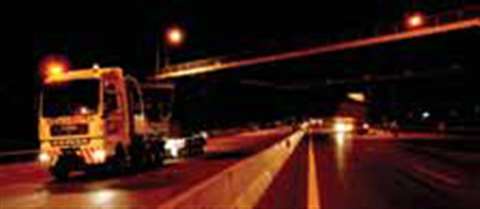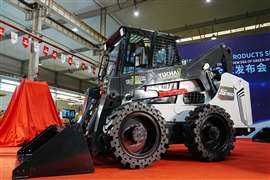Bridges in the night
26 February 2008

In recent months Spain's capital Madrid has seen the construction of many road improvements to ease traffic congestion in the overcrowded areas south of the city centre.
One is a new arterial road for the nearby town of Valdemoro. Ferrovial was contracted for the construction by Madrid municipality. The most controversial stretch of the route is the intersection with the six-lane NI-V highway. Another challenge was the high voltage U-shaped catenary overhead power lines for trains on the Aranjuez line.
Construction of this section of road was designed with five bridge spans, two of them covered by reinforced concrete beams and the other three of welded steel. Tecade Group contracted crane and transport company Transportes y Grúas Aguado for the unloading, site transport and lifting of the most important pieces of the bridge.
The assembly was divided into two parallel 60 m long bridges for each carriageway. Placement and storage on site was determined by the features of the job site and by other considerations, for example, the need to minimise traffic congestion. Planning was made more difficult by these work limitations and the necessity for interruptions to rail services.
The reinforced concrete sections came from Seville. On arrival at the site the spans were unloaded and assembled with two Aguado Liebherr LTM 1250 telescopic wheeled mobile cranes. When the two pieces of the two sides were assembled the most complex manoeuvre was designed. This was the central 60 m long, 160 tonne piece, which closed the central section of the bridge.
The technical department of Transportes y Grúas Aguado arranged a manoeuvring plan that took advantage of its new Goldhofer TPHSL specialized transport equipment. Two twin modular trailers of four axles each were assembled to do the job using the minimum of axles to minimise friction in the turns along the route. To improve the turning radius and flexibility, the modular trailers were arranged in dolly configuration.
They were pulled by two MAN TGA660 8x4 prime movers with 250 tonne capacity yokes and counterweighted with 20 and 16 tonnes each. The modular trailers had two 200 tonne capacity Goldhofer turntables. Aguado asked for the welding of four points to fit chains to tie the turn tables to the modular trailer in case of lateral movements. The two teams with Aguado drivers had an hydraulic power pack and manual steering control.
Loading was done with a Terex Demag AC 700 and a Liebherr LTM 1250 telescopic wheeled mobile crane. At 10 p.m. the convoy moved off to the great anticipation of the crowd and of the Ferrovial engineers. When the two prime movers began the manoeuvre to reverse into the assembly area there were many difficulties presented by the length of the vehicle. Several signs, streetlamps and other objects had to be removed to allow the 75 m vehicle to pass. When the first manoeuvre was finished, one of the prime movers was moved to push the back dolly.
Traffic closure pressures
At 11 p.m. all six lanes of the highway were closed and traffic police prepared an alternative route. The road was going to be reopened at 7 a.m. so time was limited. The team entered the carriageway of the N-IV to Madrid, going under a concrete rail bridge with 1 m of clearance. The concrete barrier of the highway's central reservation was opened up at 300 m and when the load arrived half of the set passed to the other lane leading to Cordoba and was taken in tow with the prime mover.
The hook of one of the cranes marks the spot where the transport is to stop for unloading
Holding the bridge section in its final position for welding
One end of the steel box section is suspended from a Manitowoc 15000 while the other end is about to be lifted off the transport by a Terex Demag AC 700
Step by step the piece was moved to the point of hook of the first crane. For the main lift to assemble the bridge Gruas Aguado used two cranes. One was a Manitowoc 15000 crawler with full counterweight and the other was a Terex Demag AC 700 telescopic wheeled mobile.
The operation was designed so that if welding took longer than the time required by Ferrovial, the cranes would not be on the carriageway if the road had to be reopened to traffic. In addition, to allow lateral road traffic to continue unhindered, the crawler crane was placed nearby and tracked to a lower road when the road was closed to traffic.
The AC 700 was set at the same height on the other side of the N-IV with 55.5 m of main boom and 160 tonnes of counterweight. The hooks of the two cranes were positioned over the road marking the place where the modular trailers should be parked.
The first modular trailer brought the piece without any problem to the lead of the hook of the Manitowoc 15000, which coupled it and raised it gradually. At that moment the manoeuvre became more complex because the prime mover on the opposite carriageway had to reverse while the Manitowoc was moving towards the span and walking back. Power to the catenary had been cut for the duration of the operation.
The half of the piece was slowly turning, supported by the modular table, until it arrived at the AC 700. It was hooked up using shackles and the crane started to raise it to clear the Manitowoc. The two cranes started to gradually raise the 160 tonnes at the same time to insert it through the platform.
The cranes held the load while it was welded. This took until 6.45 a.m. when the police got ready to reopen the highway. The Manitowoc was moved back to free access to the carriageway that was full of trailers from a department store central warehouse ready to make deliveries.
On release of the second crane Ferrovial engineers congratulated the Gruas Aguado team for their successful execution of such a complicated lifting operation.






